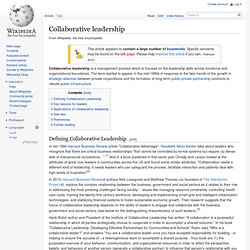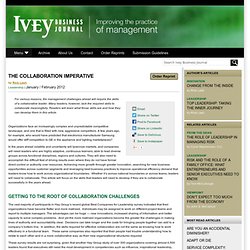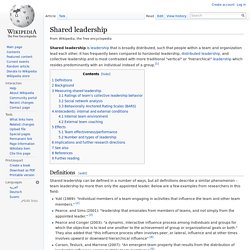

This is my personal blog on living collective leadership. I write for anybody who believes that this world needs more collective action for sustainability and wonders how best to get there. It is meant to inspire you with th. Leadership is Not Enough. Leadership is Not Enough Much is made of the importance of leadership, and I don’t disagree.

However, what’s often overlooked is the importance of system conditions. Deming talked about this when he pointed out most troubles and possibilities for improvement come from the system. Think about it like this… Imagine yourself as the world’s most inspirational leader. Unfortunately, they keep tipping over. Here’s another example. Last one. Of course, this applies at every level and goes all the way to the top. Collaborative leadership. Collaborative leadership is a management practice which is focused on the leadership skills across functional and organizational boundaries.

The term started to appear in the mid-1990s in response to the twin trends of the growth in strategic alliances between private corporations and the formation of long term public private partnership contracts to rebuild public infrastructure. Defining Collaborative Leadership[edit] In her 1994 Harvard Business Review article "Collaborative Advantage", Rosabeth Moss Kanter talks about leaders who recognize that there are critical business relationships "that cannot be controlled by formal systems but require (a) dense web of interpersonal connections…".[1] And in a book published in that same year Chrislip and Larson looked at the attributes of great civic leaders in communities across the US and found some similar attributes. Key lessons for leaders[edit] Collaborative Leadership. The 12 Habits Of Highly Collaborative Organizations.
The Collaboration Imperative. For various reasons, the management challenges ahead will require the skills of a collaborative leader.

Many leaders, however, lack the required skills to collaborate meaningfully. Readers will learn what those skills are and how they can develop them in this article. Organizations face an increasingly complex and unpredictable competitive landscape, and one that is filled with new, aggressive competitors. A few years ago, for example, who would have predicted that electronics manufacturer Samsung would offer stiff competition to GE in the appliance and lighting marketplaces?
In the years ahead volatility and uncertainty will tyrannize markets, and companies will need leaders who are highly adaptive, continuous learners, able to lead diverse groups across functional disciplines, regions and cultures. Getting to the root of collaboration challenges Why has the development of collaborative leadership skills lagged the evolution of organizational structures? Collaborating in the matrix. The ABC’s of Collaboration. (Editor’s Note: scroll down for graphical versions) In my book, Flat Army: Creating a Connected and Engaged Organization (Wiley) I define collaboration as follows: The unfettered allowance and encouragement of employees to both contribute and consume knowledge, insight or ideas with any direct relationship via professional or personal networks to achieve an outcome.

If we were to elaborate on the definition, we might suggest there are ‘The ABC’s of Collaboration’: Accessible – Be approachable & available to your team & those who expect your insight & opinions.Benevolent – To be disposed and to want to do good is a key part of being collaborative with others.Challenge – Groupthink does not equal collaboration. To challenge is to professionally debate by collaborating.Deliver – Be free from restraint while getting things done. There are two infographic versions of “The ABC’s of Collaboration” found below.
I’m taking a writing break for the summer. Do you dare to share? Building Collaboration Skills. Strategies & Benefits of Fostering Intra-Organizational Collaboration. Intergroup Development Interventions. Shared leadership. Shared leadership is leadership that is broadly distributed, such that people within a team and organization lead each other.

It has frequently been compared to horizontal leadership, distributed leadership, and collective leadership and is most contrasted with more traditional "vertical" or "hierarchical" leadership which resides predominantly with an individual instead of a group.[1] Definitions[edit] Shared leadership can be defined in a number of ways, but all definitions describe a similar phenomenon – team leadership by more than only the appointed leader. Below are a few examples from researchers in this field: Background[edit] Though a relatively new phenomenon in the literature, the concept of shared leadership can actually be traced back several centuries.
Sensemaking. ComplexityLeadership.com. Ackoff, R.

& Rovin, S. (2003). Redesigning Society (Stanford Business Books) (1 ed.). Stanford Business Books. Ackoff, R. L. (1999). Re-Creating the Corporation: A Design of Organizations for the 21st Century. Allen, K. Bass, B. Bass, B. Boal, K. Cogliser, C. Ericson, R. Fiedler, F. Goldstein, J. Hazy, J. Heifetz, R. Jaworski, J. (1996). Toward a Complex Adaptive Intelligence Community. [ Top of page ] What was that? How can we change ourselves in ways we cannot predict? More directly, how do we modify our nature to enable such unpredictable changes? Before giving the right answer, there is a wrong answer that can be dismissed up front— reorganization.